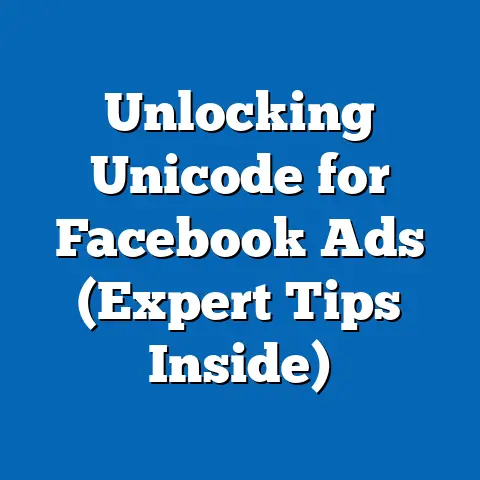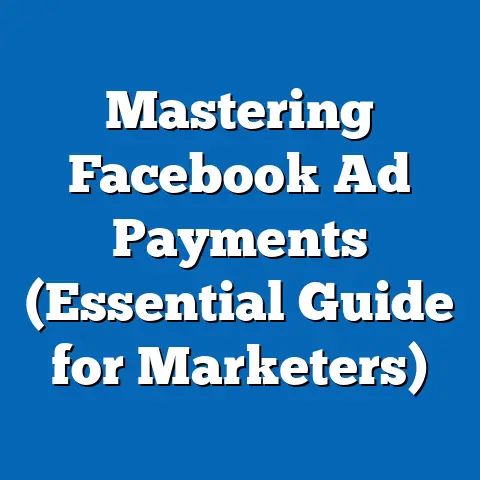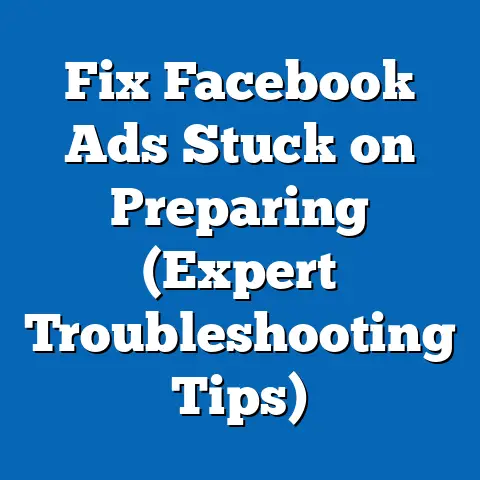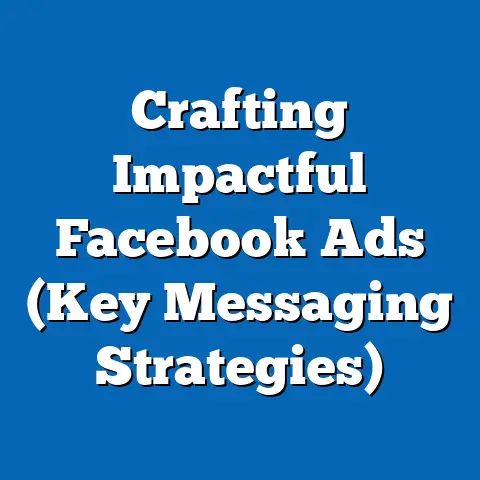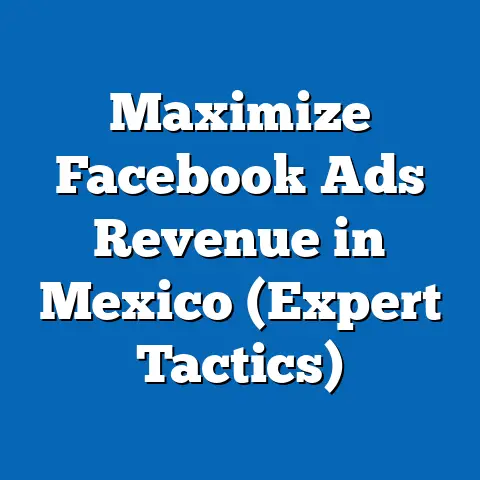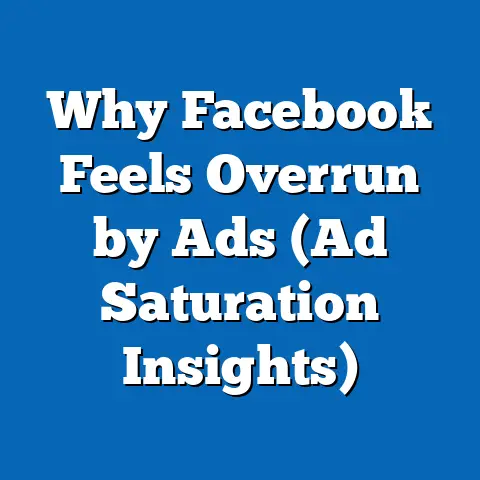Unlocking Facebook Ads: Mastering Ad Strategies (Essential Guide)
I’ve always been fascinated by the intersection of art and science, and nowhere is this more evident than in the world of Facebook advertising. Crafting effective ads is not just about throwing money at the platform; it’s an art form that requires skill, precision, and a deep understanding of your audience. It’s like being a digital sculptor, carefully chiseling away at your campaign until you reveal the masterpiece that resonates with your target market.
Facebook ads have evolved dramatically since their inception. Remember those early days of simple text ads? Now, we have a rich tapestry of ad formats, targeting options, and sophisticated analytics. As digital marketers, we’ve got to be part artist, part data scientist, and part strategist to truly succeed. Mastering this craft isn’t just about getting clicks; it’s about driving real business results, building brand loyalty, and ultimately, achieving sustainable growth.
I’ve seen firsthand the transformative power of well-executed Facebook ad campaigns. From helping a local bakery increase foot traffic by 30% to scaling an e-commerce business from zero to six figures in revenue, the possibilities are endless. But the key is to approach Facebook advertising with a strategic mindset, a creative eye, and a willingness to learn and adapt. Let’s dive into the world of Facebook Ads and unlock the secrets to crafting campaigns that truly resonate and deliver tangible results.
Section 1: Understanding the Facebook Ads Ecosystem
Before we start creating stunning ads and targeting specific audiences, it’s crucial to understand the fundamental structure of the Facebook Ads ecosystem. I often compare it to a complex machine with many moving parts, but once you grasp the basic components, you can start fine-tuning it for optimal performance.
The Core Components
At the heart of the system is the Facebook Ads Manager. This is your central command center, where you create, manage, and analyze your ad campaigns. Think of it as the cockpit of your advertising aircraft.
Within the Ads Manager, you’ll encounter several key elements:
- Campaigns: These are the overarching structures that define your advertising objective (e.g., brand awareness, website traffic, conversions).
- Ad Sets: These contain your targeting parameters, budget, schedule, and ad placements (where your ads will appear on Facebook and Instagram).
- Ads: These are the individual creative assets that users see, including images, videos, text, and calls to action.
Audiences are the lifeblood of your campaigns. Facebook offers a wealth of targeting options, allowing you to reach specific demographics, interests, behaviors, and even custom lists of customers.
Ad formats are the various ways you can present your message to users, including single image ads, video ads, carousel ads, collection ads, and more. Each format has its strengths and weaknesses, depending on your objective and target audience.
Placements determine where your ads will appear. You can choose to show your ads on Facebook’s News Feed, Instagram Feed, Audience Network, Messenger, and more.
The Algorithm: Facebook’s Secret Sauce
Facebook’s algorithm is the engine that drives ad delivery and performance. It’s a complex system that analyzes user behavior, ad relevance, and bidding strategies to determine which ads to show to which users at any given time.
Understanding how the algorithm works is crucial for crafting effective campaigns. Facebook prioritizes ads that are relevant, engaging, and provide a positive user experience. This means that you need to create high-quality ads that resonate with your target audience and align with their interests.
One of the biggest mistakes I see advertisers make is ignoring the relevance score. This score, based on expected positive and negative feedback, tells you how well your ad resonates with your audience. A low relevance score translates to higher costs and lower reach.
Key Terms and Metrics: Your Advertising Vocabulary
To navigate the world of Facebook Ads effectively, you need to speak the language. Here are some essential terms and metrics to understand:
- Impressions: The number of times your ad is displayed.
- Reach: The number of unique people who saw your ad.
- Click-Through Rate (CTR): The percentage of people who saw your ad and clicked on it (Clicks / Impressions).
- Cost Per Click (CPC): The average cost you pay each time someone clicks on your ad (Total Spend / Clicks).
- Cost Per Mille (CPM): The cost you pay for every 1,000 impressions of your ad (Total Spend / (Impressions / 1000)).
- Conversion Rate: The percentage of people who complete a desired action after clicking on your ad (e.g., making a purchase, filling out a form).
- Cost Per Acquisition (CPA): The average cost you pay to acquire a customer or lead (Total Spend / Conversions).
- Return on Ad Spend (ROAS): The revenue generated for every dollar spent on advertising (Revenue / Total Spend).
Takeaway: Understanding the Facebook Ads ecosystem is the foundation for successful campaigns. Familiarize yourself with the core components, the algorithm, and key metrics to navigate the platform effectively.
Next Step: Explore the Facebook Ads Manager interface and familiarize yourself with the different sections and features.
Section 2: Crafting Your Ad Strategy
Now that we understand the building blocks of Facebook Ads, let’s move on to the art of crafting a winning ad strategy. I believe that a well-defined strategy is the roadmap to success, guiding your campaigns towards your desired outcomes.
Defining Clear Objectives
Before you even think about creating an ad, you need to define your objectives. What do you want to achieve with your Facebook ads? Are you looking to:
- Increase Brand Awareness?
- Drive Website Traffic?
- Generate Leads?
- Increase Sales?
- Promote an Event?
Your objective will influence every aspect of your campaign, from targeting to ad creative to bidding strategy.
I’ve learned that it’s essential to be specific and measurable when setting your objectives. Instead of saying “I want to increase brand awareness,” try “I want to increase brand awareness by 20% among women aged 25-34 in the next quarter.”
Identifying and Segmenting Your Target Audience
Understanding your target audience is paramount. Facebook offers a wealth of targeting options, allowing you to reach specific demographics, interests, behaviors, and more.
Here are some of the key audience targeting tools:
- Core Audiences: Target users based on demographics (age, gender, location), interests, and behaviors.
- Custom Audiences: Upload your own customer data (e.g., email lists, phone numbers) to target existing customers or create lookalike audiences.
- Lookalike Audiences: Find new customers who are similar to your existing customers based on their demographics, interests, and behaviors.
When targeting, I like to start broad and then gradually narrow down my audience based on performance data. This allows me to identify the most responsive segments and optimize my campaigns accordingly.
For example, if you’re selling organic baby food, you might start by targeting parents with young children. Then, you could narrow down your audience by targeting parents who are interested in organic food, healthy living, or specific baby brands.
The Power of A/B Testing
A/B testing, also known as split testing, is the process of comparing two or more versions of an ad to see which one performs better. It’s an essential tool for refining your ad strategies and maximizing your ROI.
Here are some elements you can A/B test:
- Ad Copy: Test different headlines, descriptions, and calls to action.
- Visuals: Test different images, videos, and ad formats.
- Targeting: Test different audience segments.
- Placements: Test different ad placements (e.g., Facebook News Feed vs. Instagram Feed).
- Bidding Strategies: Test different bidding options.
I recommend starting with a clear hypothesis before conducting an A/B test. For example, “I believe that using a video ad will result in a higher click-through rate than using a static image ad.”
Takeaway: Crafting an effective ad strategy requires defining clear objectives, identifying your target audience, and using A/B testing to refine your campaigns.
Next Step: Define your objectives, research your target audience, and brainstorm ideas for A/B tests.
Section 3: Designing Compelling Ads
Now comes the fun part: designing compelling ads that grab attention and resonate with your target audience. I often think of this as the creative heart of your campaign, where you bring your message to life.
The Three Pillars of Ad Design
Effective ad design revolves around three key components:
- Visuals: The images and videos that capture attention and convey your message.
- Copy: The text that persuades users to take action.
- Call to Action (CTA): The button or link that prompts users to click and convert.
Eye-Catching Visuals
Visuals are the first thing users see, so they need to be eye-catching and relevant to your target audience.
Here are some tips for creating effective visuals:
- Use high-quality images and videos. Avoid blurry or pixelated images.
- Choose visuals that are relevant to your product or service.
- Use images of people, especially faces, to create a personal connection.
- Use bright colors and bold designs to grab attention.
- Consider using video ads to tell a story and showcase your product or service in action.
I’ve found that using user-generated content (UGC) can be highly effective. UGC is authentic and relatable, which can help build trust with your audience.
Persuasive Ad Copy
Your ad copy needs to be clear, concise, and persuasive. It should speak directly to your audience’s pain points and desires, and it should clearly explain the benefits of your product or service.
Here are some tips for writing effective ad copy:
- Start with a strong headline that grabs attention.
- Highlight the benefits of your product or service.
- Use strong verbs and action words.
- Create a sense of urgency or scarcity.
- Include a clear call to action.
I like to use the AIDA (Attention, Interest, Desire, Action) framework when writing ad copy. This framework helps me structure my message in a way that captures attention, generates interest, creates desire, and prompts action.
Compelling Calls to Action
Your call to action is the final push that encourages users to click and convert. It should be clear, concise, and action-oriented.
Here are some examples of effective calls to action:
- Shop Now
- Learn More
- Sign Up
- Download Now
- Get Started
I recommend testing different calls to action to see which one performs best with your target audience.
Takeaway: Designing compelling ads requires a combination of eye-catching visuals, persuasive ad copy, and compelling calls to action.
Next Step: Brainstorm ideas for visuals, write ad copy, and create compelling calls to action for your target audience.
Section 4: Budgeting and Bidding Strategies
Now that we’ve crafted our ads, it’s time to talk about money. Budgeting and bidding are critical components of your Facebook ad strategy, and they can significantly impact your ROI.
Budgeting Options: Daily vs. Lifetime
Facebook offers two main budgeting options:
- Daily Budget: Sets the average amount you’re willing to spend each day.
- Lifetime Budget: Sets the total amount you’re willing to spend over the entire duration of your campaign.
I recommend using a daily budget for ongoing campaigns and a lifetime budget for campaigns with a specific end date.
When setting your budget, it’s essential to consider your objectives, target audience, and the potential ROI. Start with a small budget and gradually increase it as you see positive results.
Bidding Strategies: Automatic vs. Manual
Facebook offers two main bidding strategies:
- Automatic Bidding: Facebook automatically sets your bids to get the most results for your budget.
- Manual Bidding: You manually set your bids for each ad set.
I recommend using automatic bidding for most campaigns, especially if you’re new to Facebook advertising. Facebook’s algorithm is sophisticated and can often find the most efficient bids for your objectives.
However, manual bidding can be useful for advanced advertisers who want more control over their bids.
Ad Scheduling and Placement Optimization
Ad scheduling allows you to specify when your ads will run. This can be useful if you want to target users during specific times of day or days of the week.
Placement optimization allows you to choose where your ads will appear on Facebook and Instagram. You can choose to show your ads on Facebook’s News Feed, Instagram Feed, Audience Network, Messenger, and more.
I recommend testing different ad schedules and placements to see which ones perform best with your target audience.
Takeaway: Effective budgeting and bidding strategies are essential for maximizing your ROI. Choose the right budgeting option, bidding strategy, ad schedule, and ad placements for your objectives and target audience.
Next Step: Set your budget, choose your bidding strategy, and optimize your ad schedule and placements.
Section 5: Analyzing and Optimizing Ad Performance
The journey doesn’t end once your ads are live. In fact, that’s where the real work begins! Analyzing and optimizing your ad performance is crucial for maximizing your ROI and achieving your objectives.
Tracking Ad Performance with Facebook Ads Manager
Facebook Ads Manager is your go-to tool for tracking ad performance. It provides a wealth of data on your campaigns, ad sets, and ads.
Here are some of the key metrics to track:
- Impressions
- Reach
- Click-Through Rate (CTR)
- Cost Per Click (CPC)
- Conversion Rate
- Cost Per Acquisition (CPA)
- Return on Ad Spend (ROAS)
I recommend creating custom reports in Ads Manager to track the metrics that are most important to your business.
Setting Up Conversion Tracking with the Facebook Pixel
The Facebook Pixel is a small piece of code that you install on your website. It allows you to track conversions and measure the effectiveness of your ads.
By tracking conversions, you can see which ads are driving the most sales, leads, or other desired actions. This information is invaluable for optimizing your campaigns and maximizing your ROI.
Ongoing Optimization Strategies
Optimization is an ongoing process. You should regularly review your ad performance and make adjustments as needed.
Here are some optimization strategies to consider:
- Adjust Targeting: Refine your targeting to reach the most responsive audience segments.
- Refine Ad Creative: Test different visuals, ad copy, and calls to action to see which ones perform best.
- Adjust Bids: Increase or decrease your bids based on performance data.
- Scale Successful Campaigns: Increase your budget for campaigns that are performing well.
Takeaway: Analyzing and optimizing your ad performance is crucial for maximizing your ROI. Track your metrics, set up conversion tracking, and implement ongoing optimization strategies.
Next Step: Set up conversion tracking, create custom reports in Ads Manager, and start optimizing your campaigns.
Section 6: Case Studies and Real-World Examples
Let’s take a look at some real-world examples of successful Facebook ad campaigns across different industries. These case studies will illustrate the strategies used, the challenges faced, and the results achieved.
Case Study 1: Local Bakery
A local bakery wanted to increase foot traffic to their store. They created a Facebook ad campaign targeting people who lived within a 5-mile radius of their store. The ads featured mouth-watering photos of their pastries and offered a special discount for first-time customers.
The campaign resulted in a 30% increase in foot traffic and a 20% increase in sales.
Case Study 2: E-Commerce Business
An e-commerce business selling handmade jewelry wanted to increase sales. They created a Facebook ad campaign targeting women aged 25-44 who were interested in fashion and jewelry. The ads featured high-quality photos of their jewelry and offered free shipping on orders over $50.
The campaign resulted in a 50% increase in sales and a 40% increase in website traffic.
Case Study 3: Software Company
A software company wanted to generate leads for their new product. They created a Facebook ad campaign targeting business owners and marketing professionals. The ads offered a free trial of their software in exchange for their email address.
The campaign resulted in a 100% increase in leads and a 20% increase in sales.
Lessons Learned
These case studies highlight the importance of:
- Clear Objectives: Define what you want to achieve with your campaign.
- Targeted Audiences: Reach the right people with your ads.
- Compelling Ad Creative: Create ads that grab attention and resonate with your audience.
- Conversion Tracking: Measure the effectiveness of your ads.
- Ongoing Optimization: Continuously refine your campaigns to maximize your ROI.
Takeaway: These case studies demonstrate the power of well-executed Facebook ad campaigns. Learn from these examples and apply the lessons to your own campaigns.
Next Step: Analyze successful Facebook ad campaigns in your industry and identify strategies you can implement.
Conclusion: Embrace the Art and Science of Facebook Ads
Mastering Facebook advertising is an ongoing journey, a blend of creativity, data analysis, and strategic thinking. It’s about understanding your audience, crafting compelling messages, and continuously optimizing your campaigns for maximum impact.
Don’t be afraid to experiment, test new strategies, and learn from your mistakes. The world of Facebook advertising is constantly evolving, so it’s essential to stay up-to-date on the latest trends and best practices.
Now, it’s time to take your first steps towards unlocking the potential of Facebook ads for your business. Define your objectives, research your target audience, and start creating compelling ads that resonate and deliver tangible results.
Embrace the art and science of Facebook Ads, and you’ll be well on your way to achieving your business goals. Let’s get started!

